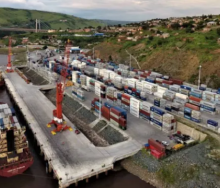Questions have been raised about safety standards and compliance related to the transportation of hazardous chemicals after another sulphuric acid spill in the Southern African Development Community (SADC).
This comes after Transist, the transit assistance bureau of the Federation of Southern African Road Transport Associations (Fesarta), reported over the weekend that another truck had contaminated an area, with sulphur pouring from its tanks.
The truck, with a holding capacity of 30 000 litres, was on its way from Durban to the Democratic Republic of the Congo (DRC) when a pipe burst some 50 kilometres north of Nata in Botswana’s north west, causing acid to spill over a wide area.
To make matters worse, according to reports the contamination had already started on January 8, the same day a tanker overturned west of Pongola, spilling acid across the road, disrupting traffic and leading authorities to issue a warning about the extreme danger of inhaling sulphuric acid or coming into contact with it.
In the Nata incident, Transist said the spill had affected a 150sqm area right across the road to Kasane, an important thoroughfare north to Botswana’s border with Namibia, Zambia and Zimbabwe.
In the Pongola incident it was reported that the company responsible had done nothing to clean up the affected area.
After the Nata spill Fesarta reported that “the transporter as the custodian of the acid has been issued with administrative instructions to rehabilitate the site”.
Botswana’s Ministry of Environment, Natural Resources, Conservation and Tourism indicated that the acid, with a concentrate level of 98%, posed a serious threat of corrosion and toxicity to people and animals in an area known for the free movement of game.
Since the two separate spills Transist has recorded various calls for decisive action against dereliction of safety standards in the transportation of chemicals such as sulphuric acid.
Some say even consignors should be held responsible. There is also a view that acid should be traced back to its source, with 90% of sulphuric acid road-hauled across the SADC originating in South Africa.
Talking about transporters involved in most such incidents, a specialist in transport across the SADC whose name is withheld, said: “They are all Zambian tankers operated by Somalis and they don’t clean up after spillages.
“In most cases they abandon their trucks.”
The source said Somali operators “bought up a lot of second-hand tankers for cash in Zambia which are not necessarily road worthy. Furthermore, they undercut prices to take business away from compliant professional transporters and have no concern for safety and the environment”.
At the time of posting this report, Fesarta had been notified of a 3rd spillage incident involving sulphuric acid, this time in the DRC. A tanker was apparently travelling between Likasi and Lubumbashi in the copper belt when it overturned.
In a video shared on Transist’s Whatsapp feed, locals can be seen walking around the contaminated area without shoes and not wearing any masks. It brings the number of sulphur spills in the SADC to three in less than a week. – Eugene Goddard.













